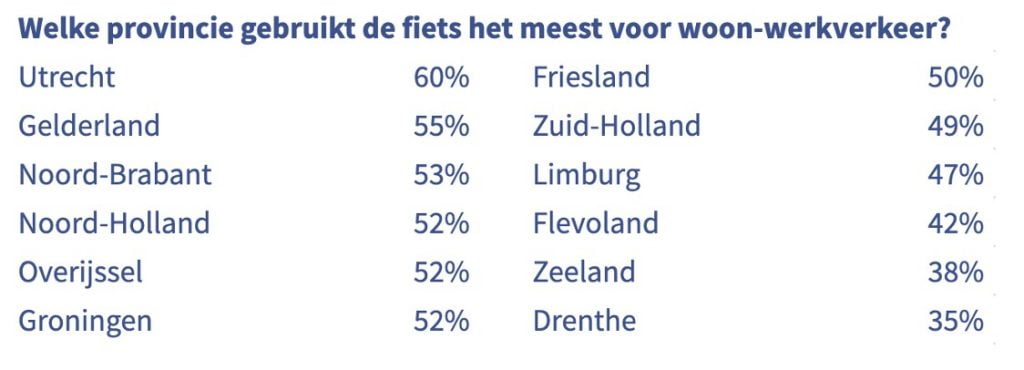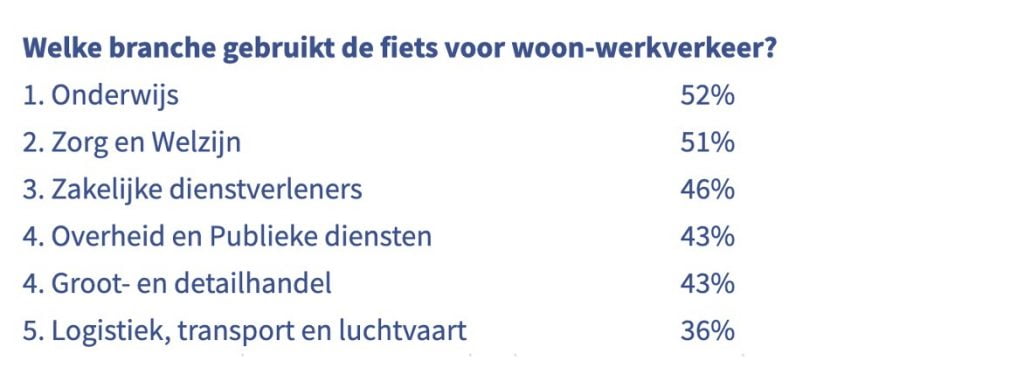Yesterday was Bike to Work Day, but what about bicycle use by working professionals? For the second year in a row, leasing company ALD Automotive conducted research into bicycle use by Dutch professionals. Have we started cycling to work more and has the pandemic had an influence on this? Which province is the frontrunner in cycling? And which industry is most in the saddle? ALD Automotive figured it out and collected the best facts. Compared to last year, there has been a slight increase in the number of professionals who use the bicycle for commuting. In 2020 this was 46 percent and another 17 percent who use the bicycle in combination with public transport. This year it is 49 and 16 percent respectively.
The number of professionals who cycle to work at least once a week has increased from 11 to 13 percent. The number of cyclists who do this every day has also increased, rising from 19 to 23 percent. The group of 'good weather' cyclists also grew from 8 to 12 percent. And the group that says they never go to work by bicycle has decreased by 7 percent (34% vs. 27%).
“All in all, we can therefore conclude that working people in the Netherlands use their bicycles more often”.
Lonneke van der Horst, Marketing & Strategy Director at ALD Automotive.
Healthy, cheap and fast
For almost half of the professionals, vitality is the main reason for taking a bicycle. COVID-19 actually no longer plays a role in this.
“Last year, 14 percent indicated that corona was a reason to use the bicycle as an alternative means of transport. Now only 1 percent. For the most part, health remains the top priority. A large group has also noticed that it is a cheaper alternative and that therefore follows in second place”.
Lonneke van der Horst, Marketing & Strategy Director at ALD Automotive.
Generation X frontrunner in cycling to work
The most avid cyclists are in the 45-59 age group. At 29 percent, it is not only the largest group who cycles to work, but at 24 percent also the largest group who does this every day. The group 30 to 44 is left behind.

Utrecht is the cycling province of the Netherlands
The province of Utrecht remains the largest cycling province with 60 percent that uses the bicycle the most to get to work. It is striking that Gelderland is now in second place with 55 percent who usually cycle to work. While last year only 14 percent indicated that they cycled daily. The growing popularity of e-bikes may have something to do with this. More than in any other province, Gelderland professionals own the most e-bikes at 38 percent. The enthusiasm for cycling to work is still lower in Drenthe than in the rest of the Netherlands: only 35 percent use the bicycle to get to work and back home.

Education staff are best represented among cycling professionals. More than half (52 percent) use their bicycle for commuting. Healthcare workers are also a bicycle-loving profession; here, at 51 percent, slightly more than half get on their bicycles. Business service providers come in third place with 43 percent, followed by employees who work in the wholesale and retail trade or work for the government.

Employer does not encourage cycling to work enough
Despite the fact that cycling to work is on the rise, there is a very large group of professionals (60 percent) who would like to cycle more often if they lived closer to work. The research by ALD Automotive shows that about three quarters of working people in the Netherlands live within a radius of 20 km. A distance that can easily be bridged with an e-bike. And even more so with a speed pedelec. At the moment, 24 percent of the respondents indicate that the employer promotes the bicycle as an alternative means of transport for commuting. In this see ALD a slight increase, as last year it was 18 percent.
"We could do better. We also asked what employers can do to encourage cycling to and from work. In 64 percent of cases, just offering a company bicycle is enough. The popularity of cycling is lacking. more on the rise. Who knows that with the current growing demand for e-bikes and some incentive from employers, we will see completely different figures next year."
Lonneke van der Horst, Marketing & Strategy Director at ALD Automotive.
Also read: FNV wins: Uber must hire drivers

